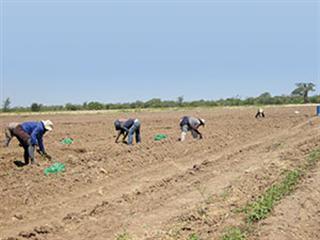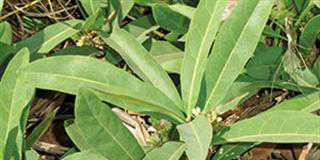
When Lufuno Managa of Mukondeni village in the Mutale area in Limpopo completed his matric in 1994, he set off for the big city to find a better life. His plan was to get an education, land a good job and settle down. He enrolled for an executive secretarial course at a Pretoria college and completed it in 1996. “The only job I could find was as a security guard,” says Lufano.
“Although I had a job, I could barely afford anything. I stayed in a small over-crowded flat and bought only basic essentials.” He found life hard and expensive in Gauteng and in 1999 he left his job, packed his belongings and went home. Lufuno told his parents that he wanted to farm and his father helped him secure 20ha in Nwanedi near Tshipise that he now leases from the government. Although he had land, capital needed to kick-start the business was a problem. “I knocked on every door but there were no answers,” he remembers.
In 2000, the Land Bank loaned him R50 000. “It was small, but it was what I needed to start,” he says. He used it to plough, pay workers and pay for electricity. “I didn’t care about other fancy things,” he recalls. He started by working only 2ha. “I had to flood irrigate and it used to take me the whole week to irrigate 2ha.”
Working without profit
With limited experience, Lufuno’s first few years were difficult. “I couldn’t meet my loan payment deadline,” he says. “I was facing a really big problem and the Land Bank warned about blacklisting me. But I was determined to make a success of the farming and refused to give up. I worked hard and had the support of my father. “Many of the successful farmers in this area are old and I asked myself, ‘how can the old men do it and I can’t?’”

In 2009, Lufano won the Limpopo Vhembe District Young Farmer of the Year award. “This boosted me a lot, I invested the money into the business and bought my own equipment.” Today he produces tomatoes on about 10ha and has a yield of about 60t/ha. Vegetables such as sugar beans, green beans, okra, cabbage, butternuts, watermelons and green peppers are produced on 10ha and marketed at Tiger Brand and the Durban Market. Only a small portion of his produce is sold locally.
Caring for plants
He plants the HTX 1400m tomato variety because of its disease-resistance and good-sized, quality fruit.The farm has predominately loamy/ clay soil which he says is an advantage especially in an area that is normally dry. “Loam soil holds water longer than sandy soil and normally has enough nutrients,” explains Lufuno. “The disadvantage is that once it is too wet, it is difficult to work. If it rains too hard, there can be no weeding or ploughing. Not being able to get into the land for a few days affects my programme.” When preparing the soil it must be slightly dry and easier to work.
“Where I’m farming, we produce year round, and what we plant depends on demand. We plant tomatoes from February to June. It doesn’t mean we can’t plant in summer, but it is risky because of too much rain.” Before planting, Lufuno rips, loosens and ridges and then puts in the irrigation dripper lines. The soil has to be loose to drain well and allow proper root development.
After preparation the land is left for about a week before planting. Depending on the results of soil tests, Lufuno starts by applying 2:3:4, the standard fertiliser for tomatoes, at a rate of up to 850kg/ ha. “I would encourage a farmer to have the soil tested before growing anything on it,” he advises. After applying the fertiliser, planting begins. Lufuno aims for a plant density of between 24 000/ ha to 36 000/ha by varying the number of seeds planted per dripper point.
Effective water use
Lufuno irrigates from an electricity-powered borehole. Due to the scarcity of ground water, he irrigates according to the appearance of the plants. “Plants show when they need water,” he explains. “I drip-irrigate for three to four hours at a time and apply fertiliser through the irrigation system. I add it to the water about 20 minutes before I start irrigating, after checking the pH. I irrigate twice a week, depending on the soil moisture and plant signs of water need.”
He emphasises the importance of keeping the soil moisture at a good level, as too much moisture promotes diseases and pests. He normally sprays at seven-day intervals.
“We inspect the plants regularly. If there are no signs of pests, I may spray at a 14-day interval,” he explains.
“The same applies to fertiliser. I fertilise when the plant leaves show they need it.” Lufuno applies urea and ammonium phosphate, both high in nitrogen, during the first four weeks. The second month during the flowering stage, he cuts down on the nitrogen and applies potassium nitrate until they start bearing fruit. We also use Polyfeed foliar
spray which contains the necessary nutrients.
Fighting pests
Lufuno says there are various pests and diseases in his area. “We put chemicals into the fertiliser tank in the first week after planting to fight pests and diseases which might be in the soil and insects feeding on the stems,” explains Lufuno. The main challenge in the area is whitefly. Lufuno prevents whitefly attack on seedlings by applying Actara or Kohinor (1l/ha) and repeating it after 28 days.
He uses Sancozeb 80 WP (400ml/200l) or Dithane M45 (400ml /200l )for blight and other fungal diseases, Cypermethrin (30ml/200l) for pests eating the plant stems, Steward (70g/200l) for looper caterpillar and bollworm, Comite II and Abamectin (120ml/200l) for red spider mite and Methomyl (100g/200l) for other unwanted caterpillars. All are mixed with a sticker to enhance their efficacy. Lufuno uses a 2 400l boom sprayer.
Future plans
Lufuno says that expansion may take time. “I must not grow too fast. Land is difficult to find in Limpopo with many farms under claim. Some have already been handed over to Community Property Associations, which are difficult to deal with. “My goal is to grow and create more jobs but, most importantly, contribute towards making South Africa food secure. The world population is growing rapidly, and there aren’t many farmers coming into the sector,” he concludes.
Contact Lufuno Managa on 079 867 4605













